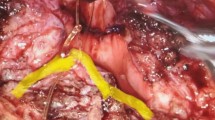Abstract
Background and objectives
Pain control in outpatient rigid cystoscopy is often achieved via the application of intraurethral lidocaine jelly. This clinical trial was designed to test the effectiveness and safety of a new method to provide local anesthesia, transperineal urethrosphincteric block (TUSB), prior to rigid cystoscopy.
Methods
Male patients posted for outpatient rigid cystoscopy were randomized to receive TUSB (group A) using 10–20 ml of 1% lidocaine, intraurethral 30 ml of 2% lidocaine jelly (group B) or intraurethral 30 ml of neutral jelly (group C) as a method of pain control. Following the procedure, plasma concentrations of lidocaine were measured in group A patients. Outcome assessments included mean urethral and sphincteric numerated pain scores (0–10), overall discomfort level (0–4) and plasma lidocaine levels.
Results
One hundred and fifty patients were recruited, 50 in each group. When the three groups were compared, the ratio of group A patients with sphincteric pain score ≥2 was significantly the least. Also, the ratio of group A patients with discomfort level ≥2 was significantly less than the same ratio in either group B or C. Plasma lidocaine concentrations were within nontoxic levels and never exceeded 2.83 μg/ml in 39 subjects.
Conclusion
This study demonstrates that TUSB is an effective and safe method in significantly relieving the pain associated with outpatient rigid cystoscopy. TUSB may offer urologists and anesthetists an alternative way to achieve pain control besides intraurethral lidocaine jelly during rigid cystoscopy.


Similar content being viewed by others
References
Kobayashi T, Nishizawa K, Ogura K (2003) Is instillation of anesthetic gel necessary in flexible cystoscopic examination? A prospective randomized study. Urology 61:65–68. doi:10.1016/S0090-4295(02)02002-2
Ye G, Rong-gui Z (2002) Optical urethrotomy for anterior urethral stricture under a new local anesthesia: intracorpus spongiosum anesthesia. Urology 60:245–247. doi:10.1016/S0090-4295(02)01732-6
Issa MM, Perez-Brayfield M, Petros JA, Anastasia K, Labadia AJ, Miller LE (1999) A prospective study of transperineal prostatic block for transurethral needle ablation for benign prostatic hyperplasia: the Emory University Experience. J Urol 162:1636–1639. doi:10.1016/S0022-5347(05)68185-2
Rodriguez A, Kyriakou G, Leray E, Lobel B, Guille F (2003) Prospective study comparing two methods of anaesthesia for prostate biopsies: apex periprostatic nerve block versus intrarectal lidocaine gel: review of the literature. Eur Urol 44:195–200. doi:10.1016/S0302-2838(03)00188-X
Khan MA, Beyzade B, Tau W, Virdi JS, Potluri BS (2002) Effect of the rate of delivery of lignocaine gel on patient discomfort perception prior to performing flexible cystoscopy. Urol Int 68:164–167. doi:10.1159/000048443
Atanassoff PG, Weiss BM, Brull SJ (1998) Lidocaine plasma levels following two techniques of obturator nerve block. J Clin Anesth 8:535–539. doi:10.1016/S0952-8180(96)00117-1
Dale F (1993) Postoperative pain in the elective surgical patient. Br J Nurs 2:842–844, 846, 848–849
Klopfenstein CE, Forster A, Van Gessel E (2000) Anesthetic assessment in an outpatient consultation clinic reduces preoperative anxiety. Can J Anaesth 47:511–515
Kiyohara LY, Kayano LK, Oliveira LM, Yamamoto MU, Inagaki MM, Ogawa NY et al (2004) Surgery information reduces anxiety in the pre-operative period. Rev Hosp Clin Fac Med Sao Paulo 59:51–56. doi:10.1590/S0041-87812004000200001
Rodríguez-Rubio F, Sanz G, Garrido S, Sánchez C, Estudillo F (2004) Patient tolerance during outpatient flexible cystoscopy—a prospective, randomized, double-blind study comparing plain lubrication and lidocaine gel. Scand J Urol Nephrol 38:477–480. doi:10.1080/00365590410018666
Taghizadeh AK, El Madani A, Gard PR, Li CY, Thomas PJ, Denyer SP (2006) When does it hurt? Pain during flexible cystoscopy in men. Urol Int 76:301–303. doi:10.1159/000092051
Ko HY, Kim KT (1997) Treatment of external urethral sphincter hypertonicity by pudendal nerve block using phenol solution in patients with spinal cord injury. Spinal Cord 35:690–693. doi:10.1038/sj.sc.3100471
Stein M, Lubetkin D, Taub HC, Skinner WK, Haberman J, Kreutzer ER (1994) The effects of intraurethral lidocaine anesthetic and patient anxiety on pain perception during cystoscopy. J Urol 151:1518–1521
Goldfischer ER, Cromie WJ, Karrison TG, Naszkiewicz L, Gerber GS (1997) Randomized, prospective, double-blind study of the effects on pain perception of lidocaine jelly versus plain lubricant during outpatient rigid cystoscopy. J Urol 157:90–94. doi:10.1016/S0022-5347(01)65292-3
Pliskin MJ, Kreder KJ, Desmond PM, Dresner ML (1989) Cocaine and lidocaine as topical urethral anesthetics. J Urol 141:1117–1119
Müntener M, Fatzer M, Praz V, Straumann U, Strebel RT, John H (2005) Local anesthesia for transurethral manipulations: is a transrectal periprostatic nerve block effective? World J Urol 23:349–352. doi:10.1007/s00345-005-0020-8
Eardley I, Broome GD, Murray A, Ramsay JW, Whitfield HN, Wilkinson DJ (1989) Plasma lignocaine levels during transurethral prostatectomy. Ann R Coll Surg Engl 71:278–280
Mazze RI, Dunbar RW (1966) Plasma lidocaine concentrations after caudal, lumbar epidural, axillary block, and intravenous regional anesthesia. Anesthesiology 27:574–579. doi:10.1097/00000542-196609000-00007
Author information
Authors and Affiliations
Corresponding author
Rights and permissions
About this article
Cite this article
Al-Hunayan, A., Kehinde, E.O., Shihab-Eldeen, A. et al. An assessment of the clinical utility of transperineal urethrosphincteric block (TUSB) in outpatient rigid cystoscopy: a single-blind, randomized study. Int Urol Nephrol 41, 47–53 (2009). https://doi.org/10.1007/s11255-008-9419-7
Received:
Accepted:
Published:
Issue Date:
DOI: https://doi.org/10.1007/s11255-008-9419-7




